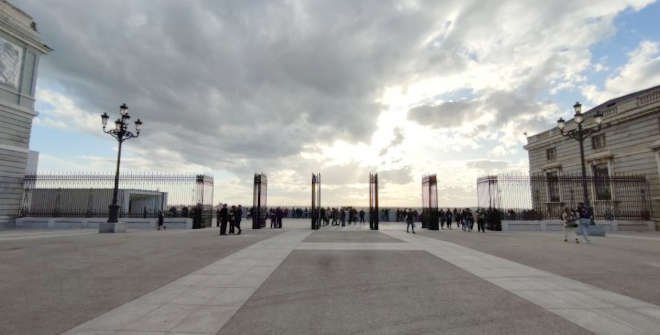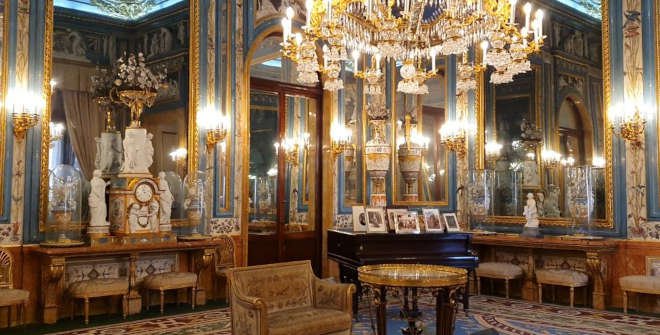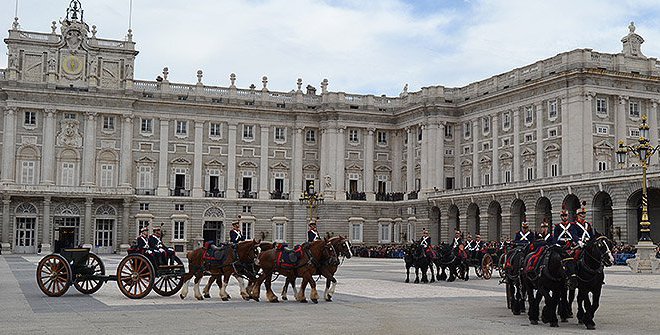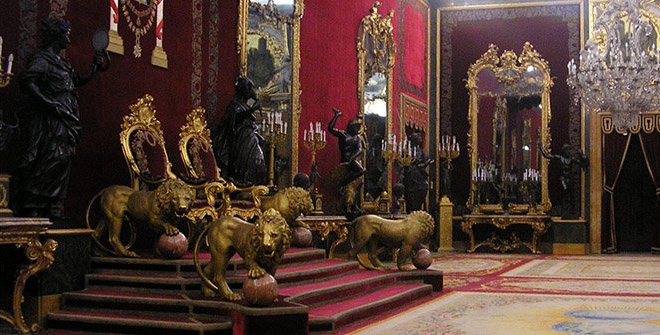Due to renovation work, access to the Palacio Real in Madrid is via the archway located on Calle Bailén, on the corner of Calle Requena.
Home to the Kings of Spain from Charles III to Alfonso XIII, Madrid's Royal Palace takes us on a journey through the history of Spain. Though it is no longer the royal family's home, it continues to be their official residence.
Long before Madrid became the capital of Spain, Emir Mohamed I chose Magerit (the city's Arabic name) as the site for a fortress to protect Toledo from the advancing Christians. The building was eventually used by the Kings of Castille until finally becoming what would be known as the Antiguo Alcázar (Old Fortress) in the 14th century. Charles I and his son Philip II turned the building into a permanent residence for the Spanish royal family. However, in 1734 a fire burnt the Palace of Los Austrias to the ground, and Philip V ordered the construction of the palace that stands today.
Following the untimely death of Filippo Juvara, the architect originally commissioned to design the palace, it was his pupil Juan Bautista Sachetti who eventually drew up the final plans. Seventeen years passed between the laying of the first stone in 1738 and final completion of the work commissioned by Philip V. However, it was Charles III (known as the "Mayor of Madrid" due to the large number of reforms and initiatives that he undertook in the city) who became the first monarch to occupy the new building. His successors Charles IV (responsible for the creation of the Hall of Mirrors) and Ferdinand VII added many decorative details and furnishings, such as clocks, items of furniture and chandeliers.
The palace, inspired by sketches made by Bernini for the construction of the Louvre in Paris, is built in the form of a square and looks out over a large courtyard with galleries and a parade ground. The decoration of the palace's rooms and their layout has gradually changed over the years as the building has been adapted to suit the needs of its residents.
It comprises over 3000 rooms, including: the Main Staircase, designed by Sabatini with over 70 steps; the Throne Hall featuring a ceiling painted by Tiepolo; the Hall of Halberdiers, which Charles III turned into the Guards Room; the Gasparini Room, with its grand 18th century decoration on a floral theme; the Royal Chemist's with natural medicine cabinets, ceramic pots made by the La Granja factory, and even prescriptions given to members of the royal family; and the Royal Chapel, which is home to a collection of string instruments made by the legendary Antonio Stradivari.
Since the end of March 2025, the Entrance to the Sacristy and the Sacristy itself are now also included on the tour. There you will see various liturgical objects and works of art, including several sculptures from the 18th century, such as La Inmaculada Concepción [The Immaculate Conception] by Manuel Álvarez, known in Spain as El Griego or The Greek, and the delicate ivory sculpture La caída de Cristo [The Fall of Christ] by Celedonio Nicolás de Arce. There are also several important paintings, such as Cristo y la samaritana [Christ and the Samaritan Woman] by Orazio Gentileschi; San José con el Niño [Joseph with the Child] by Antonio de Pereda; Cristo muerto llorado por dos ángeles [Christ Mourned by Two Angels] by Charles Le Brun, and Cristo servido por los ángeles [Christ Served by the Angels] by Pablo de Céspedes.
The Office of Charles III
From mid-September 2025, National Heritage has included the Fine Woods or Indias Room in the tourist route. This room was designed specifically for Charles III to use as an office and its decoration was commissioned to the decorator from Venice, Mattia Gasparini. This office was where Charles III held meetings with his ministers. It is now open to the public, recovering the original ensemble designed by Gasparini and crafted by the cabinetmaker, José Canops: two tables, the king's chair and a stool for the minister. Some of these pieces have been preserved in the Palacio Real in Madrid, while others were kept in the Royal Palace of El Pardo.
The opening of this space helps to enhance the museum experience and enables the public to gain a better understanding of the use and sophistication of the 18th-century Spanish palatial interiors.
The Royal Armoury and the Painting Gallery
(IMPORTANT: Due to renovation and refurbishment works, the Royal Armoury is temporarily closed)
The Royal Armoury is one of the most significant collections of its kind, housing weapons and armour worn by the kings of Spain and other members of the royal family since the 13th century. The Painting Gallery is home to a large number of artistic treasures, including Virgin with Child by Luis Morales, Portrait of Isabella the Catholic by Juan de Flandes, Salome with the Head of John the Baptist by Caravaggio and works by such artists as Velázquez, Goya, Federico Madrazo and Sorolla.

The Royal Kitchen
Reopened in October 2017 after a major renovation, the palace’s splendid Real Cocina are the oldest well-preserved kitchens of a European royal residence, notable for their size and the excellent state of their accessories. They occupy a large part of the first basement and their current appearance is the result of the redecoration ordered by Queen Isabella II and Alfonso XII between 1861 and 1880.
The visit to the Royal Kitchen does not form part of the usual tourist route of the palace and an additional fee is charged at the entrance. Visiting times in winter (October to March) are every day from 10.15am to 5pm and in summer (April to September) from 10.15am to 7pm.
Changing of the Guard
Don’t miss the Changing the guard (held on Wednesdays and Saturdays, weather permitting) and the magnificent Solemn changing the guard, which takes place on the first Wednesday of each month, weather permitting (except January, August and September).
Mirador de la Cornisa observation deck
Right between the Royal Palace and La Almudena Cathedral, you’ll find an observation deck offering stunning views of Campo del Moro Park and Casa del Campo Park. It's open daily from 12 noon to 10pm and admission is free of charge.
This space is also home to the main entrance of the Royal Collections Gallery, a must for all visitors to the city! You can access the area through any of the five gates of the wrought-iron fence, originally built in 1899 by architect Enrique Repullés Segarra to enclose the palace grounds.
 vistaaereapalacioreal.jpg
vistaaereapalacioreal.jpg PalacioReal_1404213219.138.jpg
PalacioReal_1404213219.138.jpg palacio_real.jpg
palacio_real.jpg mirador_cornisa_palacioreal.jpg
mirador_cornisa_palacioreal.jpg palacio_real.jpg
palacio_real.jpg salon_gasparini_palacio_real.jpg
salon_gasparini_palacio_real.jpg GD_PALACIOREAL_009_alta.jpg
GD_PALACIOREAL_009_alta.jpg palacio_real.jpg
palacio_real.jpg palacioreal2_1404238485.076.jpg
palacioreal2_1404238485.076.jpg palacioreal1_1404238555.585.jpg
palacioreal1_1404238555.585.jpg realcocina.jpg
realcocina.jpg sacristia_palacio_real.jpg
sacristia_palacio_real.jpg





















